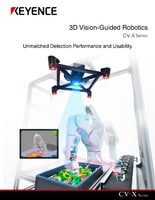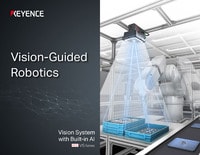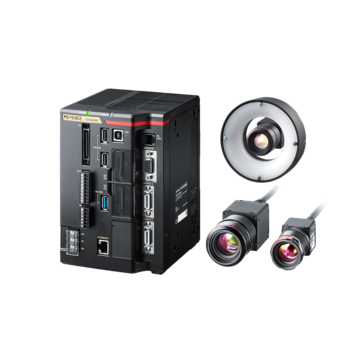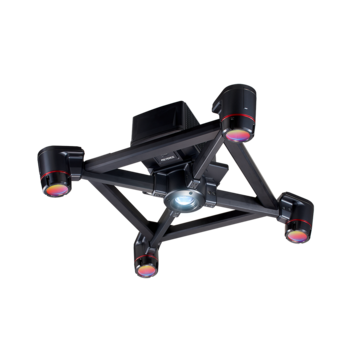Vision Systems
- Vision System with Built-in AI VS series
- Intuitive Vision System CV-X series
- Customizable Vision System XG-X series
- GigE camera and lighting for PC-based machine vision VJ series
- Inline 3D Inspection 3D Vision series
- 3D Vision-Guided Robotics 3D VGR series
- Line Scan Technology Line Scan series
- 2D Vision-Guided Robotics 2D VGR series
- LED Lighting CA-D series
- Lenses (for Machine Vision) CA-L series
- Machine Vision System Database VisionDatabase series
- Automotive
- Automation Equipment/Machine Building
- Electric Vehicles
- Medical Device Manufacturing
- Food/Beverage Packaging
- Semiconductor/Manufacturing Electronics
- Vision-Guided Robotics
- Solar
- Logistics
- Commodities
- Paper Manufacturing
- Machine Tools
- Electronic Device
- Printing
- Mining/Metals
- Fabric/Textile
- Tobacco
- Marine
- Aerospace
Vision Systems for the Robotics Industry
Explore our vision-guided robotics solutions designed to streamline both 2D and 3D guidance projects. Discover applications related to vision-guided robotics.
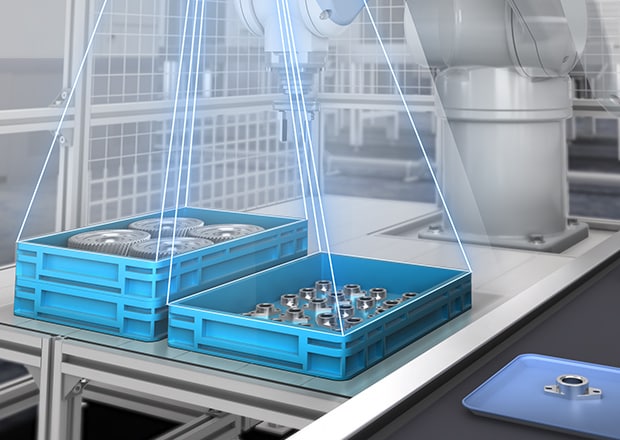
The robotics industry, particularly in industrial process automation, relies heavily on machine vision systems for performing various functions, such as bin picking, quality control, and object recognition and handling.
KEYENCE offers comprehensive machine vision solutions to enhance and optimize robot performance across various industries and industrial applications.
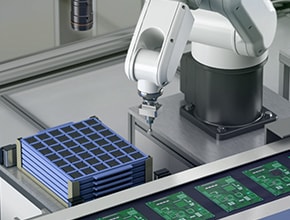
Pick and place
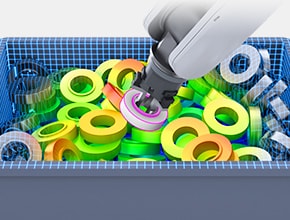
Bin picking
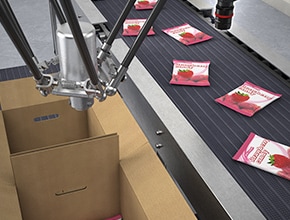
Robot guidance for candy packaging
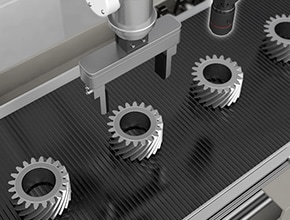
Picking by robots
Applications of Vision-Guided Systems
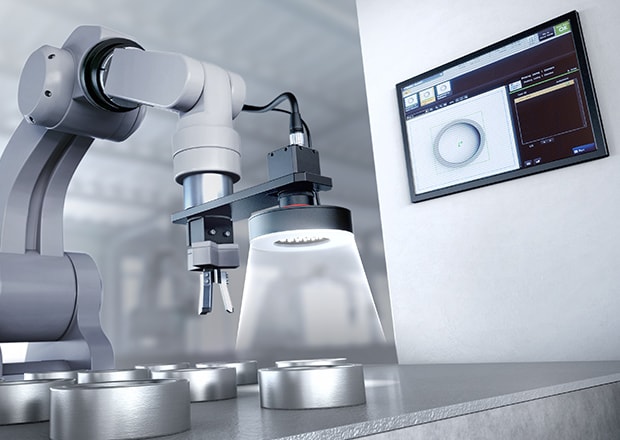
Vision-Based Navigation for Robots
KEYENCE’s CV-X Series offers unmatched detection performance and usability, allowing automatic calibration from the vision system to the robot. This leads to a significant reduction in labor hours for creating robot programs, improves cycle times, eliminates waste from poor designs, and offers a dramatic improvement in success rate and unparalleled safety.
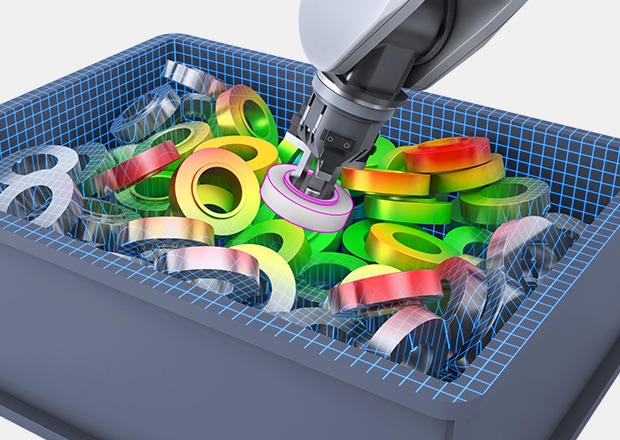
Bin-Picking
KEYENCE developed 3D search algorithms and optical systems that deliver high precision and high-speed performance for bin-picking applications. These systems rely on four separate 3D cameras to create a 3D image free of blindspots, providing the robot with optimum detection results. These are further backed by functions such as HDR image processing and multiple reflection suppression.
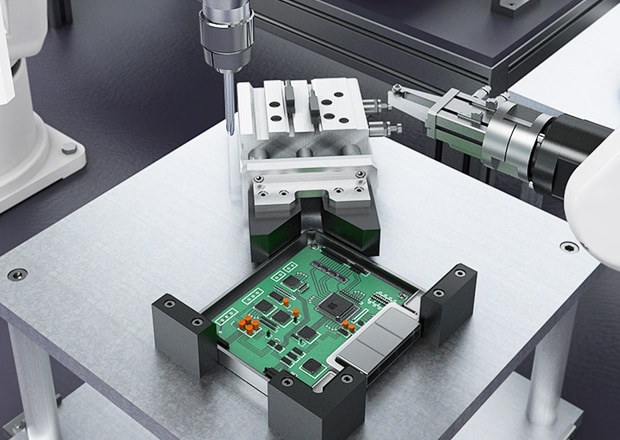
Quality Control in Robotic Manufacturing Processes
Many industrial assembly lines rely on robots for heavy lifting and other tasks. These robots rely on precise machine vision systems to perform navigation and object recognition and avoid collisions with other robots or humans during operations, ensuring the quality of the end product.
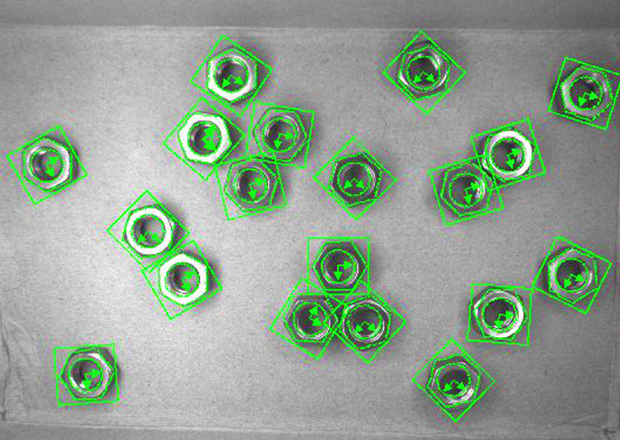
Object Recognition and Handling in Robotics
Machine vision systems for the robotics industry use a combination of hardware, cameras and sensors with integrated software solutions, such as machine learning and artificial intelligence algorithms, to recognize objects and handle them in a way that provides efficient and safe operation.
We’re here to provide you with more details.
Reach out today!

FAQs About Vision-Guided Robotics
What Are the Benefits of Using Vision Systems for Robotic Guidance?
Benefits of using a machine vision system for robotic guidance include:
- Enhanced accuracy and precision
- Improved versatility
- Better adaptability to changes in the environment
- Enhanced object recognition
- Reduced product damage
- Safety improvements
What Types of Vision Systems Are Commonly Used in the Robotics Industry?
Vision systems for the robotics industry use a variety of imaging technologies along with advanced artificial intelligence and machine learning algorithms to operate. This includes 2D and 3D scanners and camera systems, as well as a plethora of sensors to derive environmental and target data.
What Challenges Do Vision Systems Help Address in the Robotics Industry?
Vision systems for the robotics industry help address various issues, most of which are related to object recognition and classification, spatial navigation and obstacle avoidance, precision and accuracy in task execution, and adaptability to variable tasks and environment changes—these qualities make vision systems great for quality control.
How Do Vision Systems Support Traceability and Compliance Requirements in the Robotics Industry?
Many industries, including manufacturing and commerce, rely on product traceability for logistics and compliance purposes. Vision systems associated with pick-and-place robots can track components, products, and processes, ensuring operational activities meet the required standards.
What Are the Primary Considerations When Selecting Vision Systems for the Robotics Industry?
Selecting an appropriate robot vision system for your particular application is application-dependent and involves considering factors like resolution and image quality, processing speed, field of view and depth of field, integrability with your existing system, and, of course, costs.
What Are the Steps in Implementing Vision Systems for Robotics?
Implementing an adequate vision system that satisfies your application requirements effectively starts by defining the requirements themselves, followed by the selection of the appropriate vision system and choosing the right hardware and software solutions.
What Challenges Does Vision-Guided Robotics Address?
Vision-guided robotics address a wide range of challenges associated with complex object manipulation, dynamic environment navigation, quality control, and inspection, as well as the precision requirements for placement and assembly tasks.
What Are The Key Elements of a KEYENCE Robotic Vision System?
The key elements of KEYENCE’s robotic vision systems include: a 3D vision-guided robotics controller, a 3D vision-guided robotics camera input unit, a dedicated 3D vision-guided robotics camera, and 2D area camera options. All these systems use an automatic calibration between the vision system and the robot.
What Applications Can Benefit From a Vision-Guided Robotics Solution?
Applications that would benefit the most from a vision-guided robotics solution are industry-specific. For example, manufacturing and assembly industries would benefit from precision assembly, while quality control would benefit from automated defect detection and dimensional verifications. The list of examples isn’t short, and any industry that would benefit from robotic automation would also benefit from vision-guided robotics solutions.
Related Downloads
Related Products
Industries
- Automotive
- Automation Equipment/Machine Building
- Electric Vehicles
- Medical Device Manufacturing
- Food/Beverage Packaging
- Semiconductor/Manufacturing Electronics
- Vision-Guided Robotics
- Solar
- Logistics
- Commodities
- Paper Manufacturing
- Machine Tools
- Electronic Device
- Printing
- Mining/Metals
- Fabric/Textile
- Tobacco
- Marine
- Aerospace


